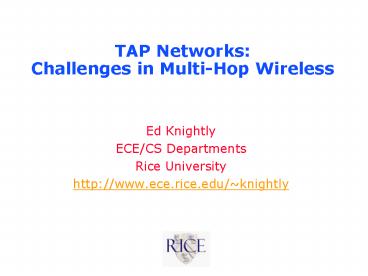TAP Networks: Challenges in Multi-Hop Wireless PowerPoint PPT Presentation
Title: TAP Networks: Challenges in Multi-Hop Wireless
1
TAP NetworksChallenges in Multi-Hop Wireless
- Ed Knightly
- ECE/CS Departments
- Rice University
- http//www.ece.rice.edu/knightly
2
Wireless Utopia
- Widely deployed wireless Internet access to hot
spots, residences, and public places - High Performance
- Scalable
- Cost Effective
- Why?
- Broadband to the home and public places
- Enabling new applications
3
WiFi Hot Spots?
- 1154 Mb/sec, free spectrum, inexpensive APs/NICs
Carriers Backbone/Internet
T1
- Problems?
- Poor economics
- High costs of wired infrastructure (10k
500/month) - Pricing 3 for 15 minutes, 6M U.S. revenue in
2002 - Dismal coverage averaging 0.6 km2 per 50 metro
areas - Poor performance scaling in dense environments
- A few residential and ISP APs starvation
4
3G Cellular? Fixed Wireless?
- 3G Cellular
- Coverage, mobility, video phone,
- Expensive spectral fees and high infrastructure
costs - Slow 100s of kb/sec
- Scaling unproven
- LMDS (Local Multipoint Distribution System)
- High bandwidth
- Large, expensive, line-of-sight transceivers (no
portability)
5
Grand Challenges
- Multi-hop WiFi Wireless Architecture
- Infrastructure costs (few wires/free spectrum)
- Scheduling and Media Access
- Goals ensure scalability, fairness, and QoS
- Challenge opportunistically exploit all
available resources - Class of distributed scheduling problems
- Class of multi-channel MAC design problems
- Control Protocols
- Route to nearest wire
- Fairness eliminate spatial throughput bias
- Proof of concept testbeds and deployments
6
Transit Access Points (TAPs) a multi-hop
architecture for scalable, deployable high-speed
wireless
- TAPs are APs with
- beam forming antennas
- multiple air interfaces
- enhanced MAC/scheduling/routing protocols
- Form wireless backbone with limited wired
gateways
7
Background Downlink MAC/Scheduling
- Problem Formulation
- N backlogged users and M channels
- Select users with best channel conditions subject
to capacity and fairness/delay constraints - Solution LK03 formulate as multi-dimensional
control problem
8
TAP Media Access and Scheduling
- Challenge distributed scheduling
- Others channel states, priority, backlog
condition unknown - Ex. TAP As best recvr may be transmitting
elsewhere - Ex. Traffic to be recvd may be higher priority
than that to be sent - Traffic and system dynamics preclude scheduled
cycles - Modulate aggressiveness according to overheard
information
9
Multi-Destination Routing/Scheduling
- Most data sources or sinks at a wire
- Routing protocols for any wire abstraction
- Scheduling
- At fast time scales, which path is best
(channels, contention, ) now? - Can delay/throughput gains be realized despite
TCP?
10
Distributed Traffic Control
- Distributed resource management how to throttle
flows to their system-wide fair rate? - Throttle traffic near-the-wire to ensure
fairness and high spatial reuse - TCP cannot achieve it (too slow and RTT biased)
- Incorporate channel conditions as well as traffic
demands
11
Capacity Driven Protocol DesignProtocol Driven
Capacity Analysis
- Traditional view of network capacity assumes zero
protocol overhead (no routing overhead,
contention, etc.) - Protocols themselves require capacity
- A new holistic system view the network is the
channel - Incorporate overhead in discovering/measuring the
resource - Explore capacity limits under real-world protocols
12
Problem Multiple APs/TAPs/within Radio Range
- PHY Interference has disproportionate throughput
degradation at MAC layer - Interference can lead to severe scaling
limitations and starvation (worse than zero-sum
game)
13
Opportunistic Channel Skipping
- Observe Channel characteristics are largely
independent - Protocol Multi-channel OAR, opportunistically
exploit multiple best channels - If a channel is poor quality (due to other APs or
fading), SKIP it - Key question when to stop skipping
- Balance incurred overhead with throughput gain of
discovering a better channel - Analogous to house selling problem
14
Prototype and Testbed Deployment
- FPGA implementation of enhanced opportunistic,
beamforming, multi-channel, QoS MAC - Build prototypes and deploy on Rice campus and
nearby neighborhoods - Measurement study from channel conditions to
traffic patterns
15
Summary
- WiFi footprint is dismal
- Removing wires is the key for economic viability
- Open challenges in architecture, protocols, and
capacity limits

